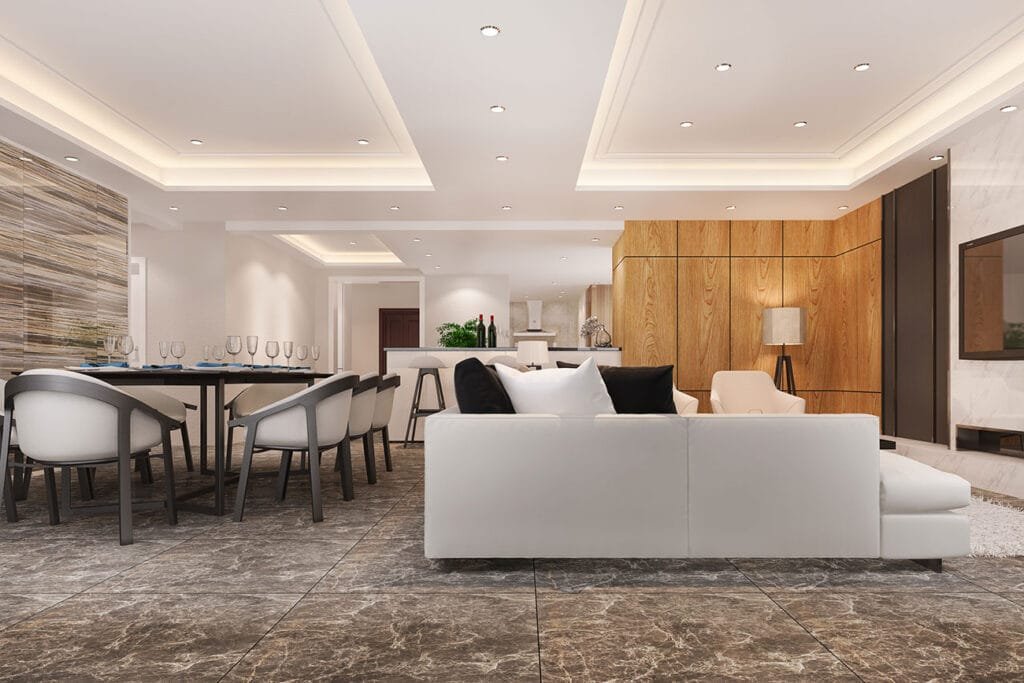
Basement Ceiling Options (Drywall vs Drop) for Indiana Homes
Basement ceilings do more than hide pipes. The choice between drywall and a drop ceiling affects headroom, sound between floors, access to shutoffs and junction boxes, lighting glare, and total cost. For Terre Haute and Vigo County homes, the best solution is the one that preserves height where people walk, keeps noise down, and still lets you reach what matters later.
What Matters Most in a Basement Ceiling
Start with clear walk paths and headroom. If beams or ducts cross the room, align soffits in straight, intentional runs along walls or hallways so the main areas still feel tall. Map every service point before you close anything: main water shutoff, pressure-reducing valve, cleanouts, traps, and any electrical junction boxes that must remain accessible. If you’re adding HVAC, plan return-air pathways so doors can close without pressure issues, using undercuts or transfer grilles as needed. Lock in the lighting early—low-profile wafer LEDs preserve height and layer task and accent light so work zones are bright without washing out a TV or media wall.
Ready to finish the whole space? Explore our full-service Basement Finishing in Terre Haute—dry, quiet, and code-right from day one.
Quick priorities for best results:
- Keep walk zones tall with straight, aligned soffits
- Pre-plan access to shutoffs, cleanouts, and junction boxes
- Balance air with returns/transfer grilles to avoid door pressure
- Use wafer LEDs and layered lighting to reduce glare and shadows
Drywall Ceilings
Drywall delivers a true residential look and the most perceived height. It finishes smooth, paints cleanly, and works great with low-profile wafer LEDs. In many Indiana and Terre Haute basements, drywall is the right call when plumbing and electrical can be rerouted into a couple of straight, intentional soffits and you only need access at known service points. Use discreet access panels over a backflow preventer, plumbing cleanout, or required electrical junction box so maintenance stays simple without a checkerboard ceiling.
Plan for the tradeoff: future changes mean cut-patch-paint. If you expect to add a mini-split line set later or relocate a valve, place access where it’s likely to matter. For sound between floors, drywall can be excellent with the right build: mineral wool in the joists for absorption, resilient channel or clip-and-channel to decouple, and a second layer of 5/8-inch Type X where privacy or theater performance matters. Pair that with solid-core doors and sealed returns to control flanking paths.
Drywall quick wins:
- Route utilities into straight soffits that preserve headroom in walk zones
- Add clean, code-compliant access panels at shutoffs and junction boxes
- Use wafer LEDs and pre-plan switch zones and dimmers to reduce glare
- Upgrade acoustics where it counts with mineral wool, RC/clip systems, and heavier drywall
Drop (Suspended) Ceilings
Modern suspended ceilings can look residential when you use a low-profile 9/16″ grid and upgraded acoustic tiles. Serviceability is the big win: tiles lift out so shutoffs, plumbing traps, and electrical junction boxes stay accessible without demolition. Over the life of a basement, especially if you anticipate upgrades this saves time and cost. Sound performance can also improve with higher-NRC tiles and light insulation above the grid, while keeping a return-air path if the ceiling plenum is part of your HVAC design.
Expect a small hit to perceived height and be selective with materials so it doesn’t read like an office. Choose smooth, drywall-look or fine-textured residential tiles, and center the grid layout to the room for cleaner lines. Plan lighting from the start: use low-glare, dimmable LED panels or wafer fixtures with grid adapters, and manage reflections near a TV or media wall. If you need frequent access or you’re isolating a mechanical bay, a drop ceiling is often the most practical choice for Terre Haute and Vigo County homes.
Drop ceiling quick wins:
- Use a low-profile 9/16″ grid with residential, fine-texture tiles for a clean look
- Center the grid to the room and align with soffits and hallways to preserve sightlines
- Specify higher-NRC tiles and add light insulation above the grid where acoustics matter
- Plan dimmable LED panels or wafer-in-grid lighting and control glare at media walls
Hybrid Solutions That Work in Vigo County
The highest-performing basements in Terre Haute often mix both systems. Keep drywall in primary living zones for a tall, seamless look, and switch to a low-profile 9/16″ drop grid over laundry, mechanicals, and dense valve clusters so shutoffs, traps, and junction boxes stay serviceable. Where you choose all-drywall, add clean, paintable access panels at known service points and align soffits in straight, intentional runs so they read architectural, not piecemeal. This hybrid approach preserves headroom where people walk, controls noise where it matters, and makes future plumbing or electrical work fast and predictable.
Hybrid quick wins:
- Drywall the main living areas; use drop grid over mechanical and utility zones
- Align soffits with walls/hallways to keep walk paths tall and sightlines clean
- Add discreet access panels at shutoffs, cleanouts, PRVs, and junction boxes
- Standardize lighting: wafer LEDs in drywall zones; dimmable panels/wafer-in-grid in drop areas
- Target acoustics: mineral wool + RC/clip where bedrooms/media sit under living spaces
- Plan HVAC returns/transfer grilles so pressure stays balanced when doors close
Sound Control Between Floors
Footfall and voices ride the framing unless you design for them. Start with absorption: mineral wool in the joist cavities knocks down airborne noise efficiently. Where a bedroom or media room matters, add decoupling with resilient channel or clip-and-channel to break the vibration path, then add mass with a second layer of 5/8″ drywall. Seal every seam and penetration with acoustical sealant, and control flanking paths (doors, ducts, recessed lights) so your upgrades actually perform. Target the priority rooms and keep the rest simple for best value.
Sound control quick wins:
- Fill joists with mineral wool (better than fiberglass for broadband absorption)
- Use resilient channel or clips; avoid short-circuiting with over-driven screws
- Add a second 5/8″ layer and stagger seams for extra mass
- Seal perimeters/boxes with acoustical caulk and backer rod at gaps
- Choose wafer LEDs or backer boxes; avoid open can lights in isolated ceilings
- Control flanking: solid-core doors, weatherstrips, door sweeps, lined/quiet ducts
Lighting Plans for Low Ceilings
Light is what makes a basement feel finished. Low-profile wafer LEDs keep ceilings high and spread light evenly without big housings. Put the media wall on a dimmer to control glare, and add task lighting at desks, benches, laundry, and kitchenettes so the ambient level can stay comfortable. Use accent light in corners, niches, and along stair treads to cut shadows and improve safety. Group fixtures into sensible switch zones and use 3-way or 4-way controls at entries and stairs so you’re not backtracking in the dark.
Lighting quick wins:
- Choose wafer LEDs or thin surface-mount fixtures to preserve headroom
- Use 3000–3500K in living zones; 4000K is fine for shops/laundry
- Space wafers ~4–5 ft apart; keep rows aligned with soffits and walk paths
- Put media walls on dimmers and avoid placing fixtures directly above the screen
- Add task lights at benches, desks, sinks, and kitchenettes for targeted brightness
- Layer accent light: toe-kicks, corner uplights, stair tread strips for safety and depth
- Plan 3-way/4-way switching at stairs and room entries for easy control
- In drop ceilings, use grid adapters or flat LED panels; in drywall, pre-wire for scenes
Cost and Timeline in Terre Haute
Drywall usually has lower material cost but more labor, especially where long soffits and multiple corners need taping and sanding. Drop (suspended) systems cost more in grid and tile but often install faster and can reduce lifetime service costs because utilities stay accessible. Hybrids split the difference: drywall where it matters visually, grid where access and dense utilities cluster. In Vigo County, the biggest drivers are soffit length/depth, tile and grid quality, the level of sound treatment, fixture count, and how many access points you plan into the design.
Cost and schedule quick wins:
- Separate materials vs labor in your estimate to compare drywall vs drop fairly
- Limit soffits to straight runs; complex jogs increase finishing time and cost
- Choose residential-grade, fine-texture tiles with decent NRC to avoid “office” looks
- Use access panels only where needed; too many panels add cost and visual clutter
- Right-size sound control: mineral wool in most areas; RC/clip and double 5/8″ only where privacy matters
- Standardize lighting types and spacing; fixture variety can inflate labor and wiring time
- Pre-map shutoffs, PRVs, and cleanouts so access lands in one grid bay or one panel
- Ask for a phased schedule: rough-in, inspections, drywall/finish or grid set, paint, trims
Quick Comparison
- Look & Height: Drywall feels seamless and tallest; drop sits a bit lower unless you use a low-profile 9/16″ grid with fine-texture residential tiles.
- Access & Service: Drywall needs planned access panels and later patch/paint; drop tiles lift out for instant access to shutoffs, traps, and junction boxes.
- Acoustics: Drywall excels with mineral wool + RC/clips + double 5/8″; drop improves control with higher-NRC tiles and light insulation above the grid.
- Best Use (Vigo County): Drywall in main living zones; drop over laundry/mechanicals or frequent-access areas; hybrids mix both for height + serviceability.
Frequently Asked Questions On Basement Ceilings in Indiana
What is the best ceiling for a finished basement?
Drywall gives the most residential, seamless look and the greatest perceived height. Drop (suspended) ceilings make future service easy because tiles lift out. Many Terre Haute homeowners choose a hybrid—drywall in living areas, low-profile grid over laundry/mechanicals.
Can I soundproof my basement ceiling?
Yes. Start with mineral wool in joists, then decouple with resilient channel or clip-and-channel. Add mass with a second layer of 5/8″ drywall, seal perimeters with acoustical caulk, and use solid-core doors to control flanking paths. Avoid open cans—use wafer LEDs or backer boxes.
How much does a basement ceiling cost in Vigo County?
Typical ranges are $4–$9 per sq ft, driven by soffit length/depth, grid/tile quality, sound upgrades (mineral wool, RC/clips), and lighting/controls. Drop systems often install faster but use higher-cost materials; drywall flips that (lower materials, more finishing labor).
How do you light a low basement ceiling?
Use low-profile wafer LEDs or thin surface-mount fixtures to preserve headroom. Put media walls on dimmers to manage glare, add task lights for desks/laundry/kitchenettes, and layer accent light at corners and stair treads. Plan sensible switch zones with 3-way/4-way control.

Need further assistance?
Unsure about something? Get in touch with us for a personalized consultation.
Ready To Choose the Right Basement Ceiling?
Patriot Property Pros will map headroom, align soffits, plan lighting, and recommend a drywall, drop, or hybrid ceiling that fits your home in Terre Haute.
Serving Terre Haute, Clinton, Rockville, and surrounding areas.